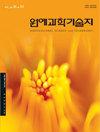Comparative Analysis between the ITS TaqMan SNP Genotyping Assay and CAPS for the Rapid Molecular Identification of Zoysia japonica and Zoysia sinica, Related Hybrid Lines, and the Habitat Distribution of Each Species
IF 0.8
4区 农林科学
Q3 HORTICULTURE
Korean Journal of Horticultural Science & Technology
Pub Date : 2023-08-31
DOI:10.7235/hort.20230042
引用次数: 0
Abstract
In this study, zoysiagrasses found in a major province of the Korean peninsula were collected and identified by molecular techniques. The zoysiagrasses used in this study were collected from mountainous national parks; ‘oreum’ areas; and from inland, coastal and island areas, including marine and coastal national parks on the west, east, and south coasts. Molecular identification was done by means of a cleaved amplified polymorphic sequence (CAPS) marker analysis based on the nrDNA-internal transcribed spacer (ITS) method established by our research team. Additionally, in this study the ITS-based TaqMan single-nucleotide polymorphism (SNP) genotyping assay was developed and used to perform molecular identification more rapidly and accurately. In total, 450 collected zoysiagrass plants were classified into three lines (234 Zoysia japonica plants, 62 Zoysia sinica plants, and 154 Z. japonica and Z. sinica hybrid plants) by molecular identification based on the ITS-based CAPS marker analysis and ITS-based TaqMan SNP genotyping assays. The results of the ITS-based TaqMan SNP genotyping assay were consistent with those of the ITS-based CAPS marker analysis. Both the ITS-based CAPS marker analysis and the ITS-based TaqMan SNP genotyping assay were found to be efficient molecular methods to identify the three species of zoysiagrasses. Specifically, the ITS-based TaqMan SNP genotyping assay method developed in this study produced results more rapidly compared to the ITS-based CAPS marker analysis method. The habitat distributions of each of the molecularly identified zoysiagrass plants investigated in this study were also assessed. The Z. japonica plants were mainly distributed in mountainous national parks and oreum areas as well as inland and coastal areas. The Z. sinica plants were distributed along the coast and on rocks and stones frequently submerged in seawater. The Z. japonica and Z. sinica hybrid plants were distributed more in the inland, coastal, and island areas than in the mountainous national parks and oreum areas. Findings related to the leaf blade width as a main external morphological classification characteristic of the molecularly identified 450 zoysiagrass plants are described below. The leaf blade width ranged from 4 to 5 mm for the Z. japonica plants, from 2 to 4 mm for the Z. sinica plants, and from 3 to 4 mm for the Z. japonica and Z. sinica hybrid plants. Additionally, some Z. japonica and Z. sinica plants and Z. japonica and Z. sinica hybrid plants with leaf blade widths of 2 to 3, 4 to 5, and from 2 to 3 and 4 to 5 mm, respectively, were also present. Because the ranges of the leaf blade width of each species overlapped, it was difficult to identify the hybrid lines using this metric. The feasibility of the developed molecular identification method for these three species of zoysiagrasses was confirmed in this study.ITS TaqMan SNP基因分型与CAPS快速分子鉴定结缕草、结缕草及其相关杂交种及生境分布的比较分析
本研究收集了朝鲜半岛一个主要省份的结缕草,并利用分子技术对其进行了鉴定。本研究使用的结缕草采自山地国家公园;“oreum”;内陆、沿海和岛屿地区,包括西部、东部和南部海岸的海洋和沿海国家公园。分子鉴定采用本课组建立的nrdna -内部转录间隔物(ITS)方法,采用裂解扩增多态性序列(CAPS)标记分析。此外,本研究还开发了基于its的TaqMan单核苷酸多态性(SNP)基因分型试验,并用于更快速、准确地进行分子鉴定。通过基于its的CAPS标记分析和基于its的TaqMan SNP基因分型分析,将收集到的450株结缕草分为3个系(234株日本结缕草,62株中国结缕草,154株日本结缕草与中国结缕草杂交)。基于its的TaqMan SNP基因分型分析结果与基于its的CAPS标记分析结果一致。基于its的CAPS标记分析和基于its的TaqMan SNP基因分型分析都是鉴定三种结缕草的有效分子方法。具体来说,与基于its的CAPS标记分析方法相比,本研究开发的基于its的TaqMan SNP基因分型分析方法产生结果的速度更快。并对分子鉴定的结缕草类植物的生境分布进行了评价。粳稻植物主要分布在山地国家公园和森林地区以及内陆和沿海地区。黄竹属植物分布在沿海和经常被海水淹没的岩石上。粳稻和中稻杂交植物主要分布在内陆、沿海和海岛地区,而不是山地国家公园和森林地区。下面描述了分子鉴定的450种结缕草植物的叶片宽度作为主要外部形态分类特征的相关发现。粳稻叶片宽度为4 ~ 5mm,黄花苜蓿叶片宽度为2 ~ 4mm,黄花苜蓿与黄花苜蓿杂交叶片宽度为3 ~ 4mm。此外,还存在叶片宽度为2 ~ 3 mm、4 ~ 5 mm、2 ~ 3 mm和4 ~ 5 mm的部分粳稻-中华稻和粳稻-中华稻杂交植株。由于各种属叶片宽度的变化范围存在重叠,因此使用该指标对杂交品系进行鉴定比较困难。本研究证实了所建立的结缕草分子鉴定方法的可行性。
本文章由计算机程序翻译,如有差异,请以英文原文为准。
求助全文
约1分钟内获得全文
求助全文
来源期刊
CiteScore
2.00
自引率
0.00%
发文量
0
审稿时长
1 months
期刊介绍:
Horticultural Science and Technology (abbr. Hortic. Sci. Technol., herein ‘HST’; ISSN, 1226-8763), one of the two official journals of the Korean Society for Horticultural Science (KSHS), was launched in 1998 to provides scientific and professional publication on technology and sciences of horticultural area. As an international journal, HST is published in English and Korean, bimonthly on the last day of even number months, and indexed in ‘SCIE’, ‘SCOPUS’ and ‘CABI’. The HST is devoted for the publication of technical and academic papers and review articles on such arears as cultivation physiology, protected horticulture, postharvest technology, genetics and breeding, tissue culture and biotechnology, and other related to vegetables, fruit, ornamental, and herbal plants.

 求助内容:
求助内容: 应助结果提醒方式:
应助结果提醒方式:


